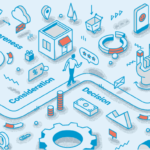Despite all the buzz about the uptick in e-commerce, retailers shouldn’t focus solely on enhancing their online shopping experience. Even though more people are more comfortable browsing and buying online, today’s shoppers aren’t seeking an either/or experience.
Only 7 percent of people shop exclusively online. Just 20 percent are in-store-only buyers. The rest – 73 percent – want to move purchase-by-purchase, experience-by-experience across online, mobile, and in-person shopping seamlessly. For retailers, it’s not enough to offer multi-channel options. It’s time to take shopping to the next level by making sure each channel works together to create a customer-centric end-to-end experience.
What omnichannel retail is (and isn’t)
It’s easy to confuse offering customers multiple paths to purchase as having an omnichannel strategy. However, true omnichannel retail happens when each channel integrates with the others to give customers a connected experience no matter where they begin and end their buying journey.
What’s omnichannel shopping? Right now, it includes placing an order online but opting to pick it up in-store. Or exploring options online and then visiting the brick-and-mortar location to view the products and make a final decision. Or looking up an item on a mobile device to see if it’s in stock before stopping by the store or placing an order. Omnichannel also means customers can use multiple channels simultaneously, such as looking up customer reviews on their smartphone as they shop in-store.
The omnichannel experience recognizes the customer all along the way, capturing and sharing data points from across the different channels so that however a customer chooses to engage, their profile and purchase history are available to personalize each shopping experience.
For retailers, omnichannel means not treating different channels as stand-alone experiences that compete for a customer’s attention. Instead, approaching the different channels as part of an integrated shopping experience pays off for retailers. Omnichannel shoppers have a nearly 30% higher lifetime value compared to those who shop only through a single channel. Retailers with strong omnichannel experiences retain an average of 89 percent of their customers vs. an average of 33 percent for those with weak omnichannel strategies. And, most significantly, omnichannel shoppers spend up to 35 percent more per transaction.
Related: How to Optimize Omnichannel Retail and Keep Customers Coming Back
POS: Your omnichannel engine
Making digital, mobile, and brick-and-mortar shopping come together seamlessly starts with having the right point-of-sale (POS) capabilities. Your POS system should serve as the main engine, driving behind-the-scenes operations as well as customer-facing experiences.
Behind-the-scenes omnichannel essentials:
- Integrated inventory: A true omnichannel customer experience is possible only when your inventory management is completely integrated. In other words, inventory can’t be managed channel by channel and then manually brought together. That’s rarely seamless or quick. Rather, seek POS system capabilities that bring together inventory management across channels to show you what you have in the warehouse, what’s sold, and what’s been ordered – in real-time. Integrated inventory enables you to tell customers what’s available and exactly where it sits – instantly and accurately.
Related: Omnichannel Inventory: Avoid These 3 Obstacles
- Data depth: One of the biggest advantages of an omnichannel strategy is the wealth of data you collect. But data is meaningless if it’s not accessible. Look to your POS system to help you capture, organize, and analyze a comprehensive set of customer, sales, and inventory data. In addition to serving up relevant data points on demand to enhance the shopping experience (see below), your POS system should make it easy to translate data into reports that help you run – and grow – your business. Establish a mix of automated reports highlighting specific customer, inventory, and sales metrics, so you have an all-in view of what’s selling, who’s buying, and the stock you have on hand.
Customer-facing omnichannel essentials:
- Personalization: Omnichannel shopping experiences thrive on personalization. Your POS data can drive personalized experiences, such as suggesting “you may also like” items at checkout, whether online or in-person, or tailoring marketing messages based on a customer’s purchase history, style preferences, or birthday. Research shows that highly personalized shopping experiences make shoppers 110 percent more likely to buy additional items.
- Checkout: At the center of most shopping experiences is the purchase process. Ensuring it’s easy and efficient is paramount, whether customers are buying in-person or online. Today’s customers expect retailers to offer a range of payment options, from cash, debit, and credit cards through contactless digital payments like Apple Pay or Google Pay and gift cards. If you don’t offer a customer’s preferred payment option, nearly half of consumers say they won’t complete the purchase. In addition, your POS system should make it easy to personalize the in-person checkout experience by putting customer profile data at the sales team’s fingertips.
Related: The Top 5 Things You Need in a POS System
POSIM is a point-of-sale and inventory management system designed to help you expand and enhance your omnichannel retail strategies. Contact us for a demo to see what POSIM can do for your business.












